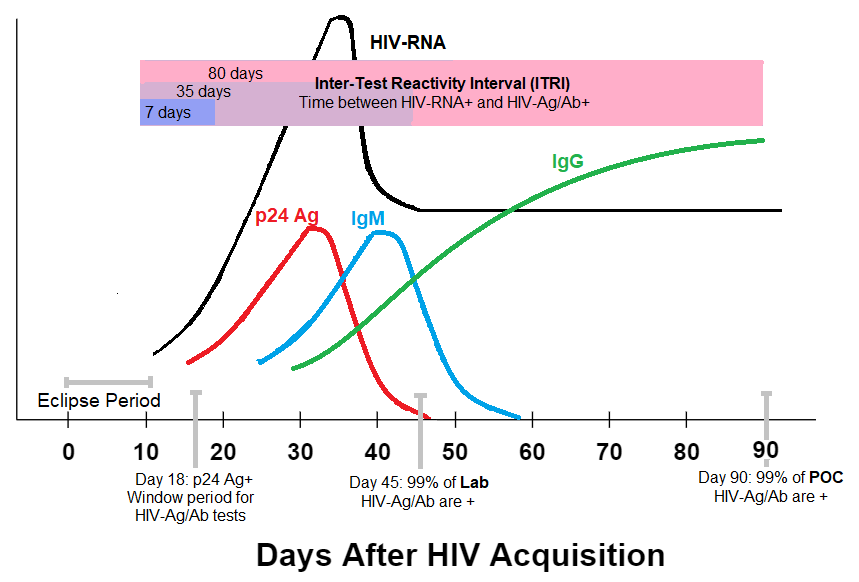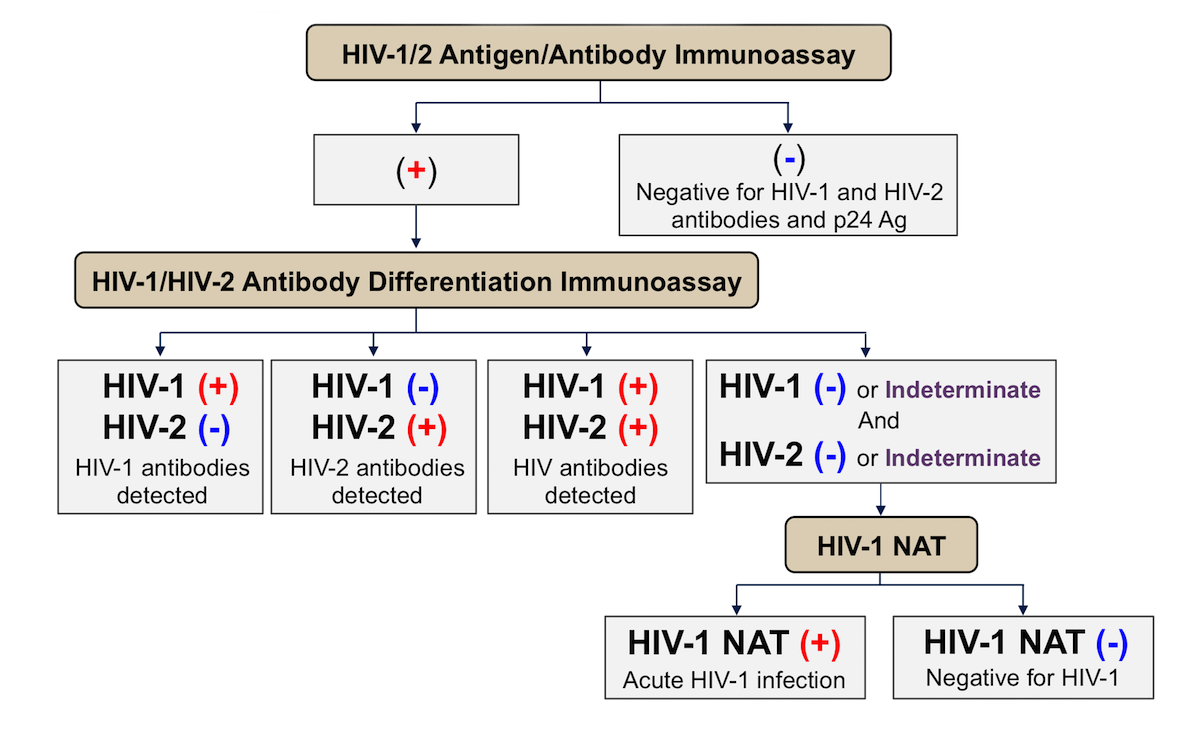PrEP Provider Toolkit
PrEP Provider Toolkit
Basics of HIV
HIV Testing
The recommended tests for HIV can vary based on the clinical scenario and the type of PrEP medication being utilized. Let’s briefly review this to build a foundational understanding of HIV testing options, their indications, and their limitations.
HIV-RNA
- Sometimes called nucleic acid test (NAT) or “viral load”
- Measures the amount of circulating HIV genetic material
- Becomes detectable ~10 days after HIV acquisition
p24 antigen (Ag)
- A structural protein found in the HIV capsid
- The antigen component of combined HIV-Ag/Ab testing.
- Becomes detectable ~18 days after HIV acquisition
HIV antibody (Ab)
- Antibodies against HIV; starts with IgM which gets replaced over time with IgG
- The antibody component of combined HIV-Ag/Ab testing
- Becomes detectable ~24 days after HIV acquisition
Click image for full size view
Click the title of the figure to view source.
Figure 3. - Timing of HIV Test Positivity After Acquisition
Fiebig, Wright, D. J., Rawal, B. D., Garrett, P. E., Schumacher, R. T., Peddada, L., Heldebrant, C., Smith, R., Conrad, A., Kleinman, S. H., & Busch, M. P. (2003). Dynamics of HIV viremia and antibody seroconversion in plasma donors: implications for diagnosis and staging of primary HIV infection. AIDS (London), 17(13), 1871–1879.
https://doi.org/10.1097/00002030-200309050-00005
Branson, B.M., Owen, M.S., Wesolowshi, L.G., Bennett, B., Werner, B.G., Wroblewski, K.E., Pentella, M.A. (2014). Laboratory testing for the diagnosis of HIV infection: updated recommendations.
https://doi.org/10.15620/cdc.23447
Delaney, Hanson, D. L., Masciotra, S., Ethridge, S. F., Wesolowski, L., & Owen, S. M. (2017). Time until emergence of HIV test reactivity following infection with HIV-1: implications for interpreting test results and retesting after exposure. Clinical Infectious Diseases, 64(1), 53–59.
https://doi.org/10.1093/cid/ciw666
Newly acquired HIV infections take some time to make substantial copies of its genome. During this eclipse period, which typically lasts 10-12 days, we are unable to detect an HIV infection with any type of test. This eclipse period also happens to be the window period for HIV-RNA tests.
The window period is the time between HIV acquisition and lab test positivity.
Each successive generation of HIV-Ag/Ab testing has worked to shorten the window period to allow for earlier diagnosis. The currently recommended and most commonly used HIV-Ag/Ab 4th-generation test checks for the p24 Ag, HIV-IgM, and HIV-IgG. The testing algorithm is presented in Figure 4. This test can be performed in the laboratory or as a point-of-care (POC). The only POC HIV-Ag/Ab test recommended in the context of PrEP is the Abbott Determine HIV-1/2 Ag/Ab Combo, a fingerstick test that generates results in 20 minutes. (1)
DetermineTM HIV-1/2 Ag/Ab Combo. (n.d.). Retrieved September 19, 2022, from
https://www.globalpointofcare.abbott/en/product-details/determine-1-2-ag-ab-combo.html
Figure 4 - HIV-Ag/Ab testing algorithm
Source: Centers for Disease Control and Prevention. (2018). Quick reference guide: recommended laboratory HIV testing algorithm for serum or plasma specimens. U.S. Department of Health and Human Services.
https://www.cdc.gov/hiv/pdf/guidelines_testing_recommendedlabtestingalgorithm.pdf
The window period for a laboratory based 4th-generation HIV-Ag/Ab test is between 18-45 days; the point-of-care (POC) version has a slightly longer window period of 18-90 days. After the window period, these tests will detect 99% of all newly acquired HIV infections.
Although HIV-RNA tests have the shortest window period, we do not routinely rely on this test for screening as it is costly and places a high burden on laboratories.
HIV-RNA is typically only used in the following scenarios:
- Monitoring disease activity in someone with a known HIV infection
- Checking for HIV acquisition during the inter-test reactivity interval
The inter-test reactivity interval (ITRI) is the time between HIV-RNA test positivity and HIV-Ag/Ab test positivity.
As highlighted in purple boxes in Figure 3, this ITRI can be as short as a week to as long as 80 days. Thankfully, it has been determined that the ITRI of current Ag/Ab tests to capture 95% of new infections is just one week. (2) In other words, the current HIV-Ag/Ab tests that we use can reliably detect new infections just a week after HIV-RNA tests can.
Delaney, Hanson, D. L., Masciotra, S., Ethridge, S. F., Wesolowski, L., & Owen, S. M. (2017). Time until emergence of HIV test reactivity following infection with HIV-1: implications for interpreting test results and retesting after exposure. Clinical Infectious Diseases, 64(1), 53–59.
https://doi.org/10.1093/cid/ciw666
However, this indicates that clinical scenarios still exist where HIV-RNA testing is needed before starting PrEP. We will be covering this in detail in the coming sections. Admittedly, this is the most challenging portion of PrEP care though it does not need to be applied in the vast majority of cases, so do not be deterred.
The recommended tests for HIV can vary based on the clinical scenario and the type of PrEP medication being utilized. Let’s briefly review this to build a foundational understanding of HIV testing options, their indications, and their limitations.


